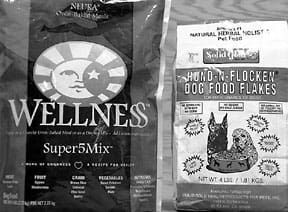[Updated October 19, 2017]
Recently there has been renewed interest in fiber as a dog food ingredient. One pet food manufacturer published an article on the Internet condemning beet pulp in dog food as unhealthy, if not downright dangerous. There is a lot of myth and misunderstanding concerning fiber, so let’s take a closer look at this controversial ingredient.
The term “fiber” (or “roughage”) applies to complex carbohydrates that are resistant to mammalian digestive enzymes, although certain bacteria possess the enzymes needed to break them down. Even ruminants, with their four-chambered stomachs and cud-chewing habits, rely on their symbiotic rumen bacteria to digest plant fiber.
Fiber is found only in plants – hair, hooves, bones, fish scales, and feathers do not contain any fiber. Fiber is composed of polysaccharides (complex sugars), and is found in plant cell walls, where it provides structural strength and rigidity.

While some food manufacturers use whole grains and vegetables to serve as both a source of nutrients and fiber – the method WDJ most admires – many others use dedicated fiber sources such as beet pulp, peanut shells, oat and other brans, tomato pomace, buckwheat and other grain hulls, psyllium, fruit pectin, guar gum and other gums, flaxseed, and powdered cellulose. This last one is defined as “purified, mechanically disintegrated cellulose . . . from fibrous plant materials.” I fondly refer to it as “sawdust,” which I believe is a fair description (though technically, wood contains a related fiber called lignin in addition to cellulose).
What Fiber Has to Offer Dogs
It’s true that the “wild” canine diet contains very little fiber, and the dog has no absolute physiologic need for it. However, dogs eating processed commercial foods do appear to benefit from the addition of fiber.
While fiber itself is indigestible and generally considered non-nutritive, some fibers do contain nutrients, such as vitamins and minerals, that can be extracted during digestion, either by the mechanical grinding action of the stomach and intestines, or through bacterial fermentation in the colon. However, the nutrients present in fiber are not the reason it is often included in dog fods.
Fiber’s major contribution to commercial dog food is modulation of the digestive process; the fiber content of a food greatly affects the speed of passage of food through the digestive system. Fiber’s moisture-absorbing and lubricating actions can slow down peristalsis (the muscular contractions of the intestine that push food through the tract) in cases of diarrhea, or speed it up in the case of constipation. In other words, fiber has a normalizing effect on the gut.
The presence of adequate fiber allows time for absorption of nutrients and water from the intestine into the blood. Some fibers also impart mucilaginous (slippery) qualities to the food, helping it “slide” along the gut walls. Certain fibers increase the rate of stomach emptying (this is one theory behind feline “hairball” diets), while others slow it down. Fiber binds some toxins in the gut and eliminates them in the stool.
Types of Fiber
Fiber is usually characterized by describing its solubility and fermentability. These terms are used for different properties, and any one fiber can be described in terms of either trait. Cellulose, for instance, is both insoluble and nonfermentable, while guar gum is soluble and fermentable. Others lie on a continuum between these two extremes. These terms evolved as the technology for analyzing fiber improved.
However, the method used to assay “crude fiber” as stated on a dog food label is actually a very poor technique, and fails to detect most of the lignan, hemicellulose, and even some of the plain cellulose. Thus, the actual level of fiber in a dog food may be considerably underestimated by the outdated Crude Fiber method.
Soluble fibers are considered more digestible than insoluble fibers and will dissolve in water. Soluble fiber dissolves in water to form a viscous gel, which may aid in food passage through the gut. Insoluble fiber tends to speed up gut motility.
Fermentable fibers are those that yield nutrients that can be used for energy by the body. Soluble fibers tend to be more fermentable than insoluble fibers. Bacterial digestion of these fibers produces short-chain fatty acids (SCFAs) such as proprionate, acetate, and butyrate. Butyrate is thought to be beneficial to the cells lining the colon. These SCFAs can be absorbed by the animal and used as an energy source, acidify the colonic environment, and draw water into the stool by osmosis. Basically, they keep the colon bacteria happy, and this is the reasoning behind use of fructo-oligosaccharides found in such plants as chicory and yucca in dog food.
Fiber and Medical Conditions
It has been thought for many years that high fiber diets are “more filling” and provide increased satiety. Thus, weight loss diets have traditionally included high fiber as well as less fat. However, a new study has reported that fiber appears to have no effect at all on a dog’s appetite; no matter how much fiber a food contained, all dogs were willing to eat a “challenge” meal given an hour later. Other researchers have suggested that the primary mechanism of weight loss produced by “light” diets may be decreased palatability.
The ability of certain fibers to decrease intestinal transit time is the theory behind feeding high-fiber foods to diabetics. The addition of fiber slows absorption, resulting in a more stable blood glucose level over time.
While different fibers behave differently depending on the composition of the diet and the individual metabolism of the dog, it seems clear that excessive fiber increases fecal bulk, frequency of defecation, and may produce loose stools and flatulence.
Beet Pulp Fiction
Beet pulp seems to be the main target for much of the misinformation flying around about fiber. Here are a couple of the untruths currently being promulgated about beet pulp:
MYTH 1: Kibble containing beet pulp swells up in the stomach and causes bloat. This is based on the observation that extruded kibble that gets wet (i.e., dropped into the water bowl) will indeed expand, and any of us with sloppy dogs (or playful cats) have seen the evidence with our own eyes. However, baked food does not swell, and several baked foods also contain beet pulp.
The expansion of wet kibble is mainly due to the air trapped in the pellet as it “pops” from the extruder. The other thing to notice about wet kibble is how easily it breaks apart. Far from forming “an indigestible mass” in the stomach, this property of kibble probably helps speed its passage from the stomach and ultimate digestion.
MYTH 2: Beet pulp is full of sugar and can cause diabetes. Pulp is a by-product of sugar extraction from sugar beets. Sugar manufacturers, obviously, extract every last little bit of sugar from the pulp before they sell the pulp off for drying and use in dog food. There is no evidence that beet pulp causes diabetes.
MYTH 3: The saponins in beet pulp cause bloat. Saponins are basically soaps, which cause an increase in surface tension of a liquid. While normal water forms bubbles, they burst rapidly. Soap allows the molecules to stick together longer. Saponins are found in beets, legumes like alfalfa and beans (including soybeans), and hundreds of other plants. Saponins are specifically associated with one type of bloat (“frothy” bloat) in ruminants (cows and goats), but this is completely unrelated to the “gassy” type of bloat that dogs can suffer from.
MYTH 4: The saponins in beet pulp contains paralytic toxins. There are thousands of saponins; the soybean alone contains at least five different ones. The highly biased claim that all saponins (or even all soy and beet saponins) are toxic is ignorant and inaccurate. According to one expert, “From the biological point of view, saponins have diverse properties, some deleterious but many beneficial.”
Medicinal herbs such as ginseng, licorice, and alfalfa contain helpful bioactive saponins. Digitalis is a saponin that is extremely toxic in high doses, but has saved millions of lives as the basis for digoxin, a drug used to treat congestive heart failure. Saponins are largely destroyed by processing such as soaking and cooking; it is unlikely they have any biological effect when consumed in dog food.
Overall, I don’t have any objection to beet pulp. For a normal animal, I’d probably choose a food that contains beet pulp or pomace – the more fermentable fibers – over peanut hulls or cellulose. And I’d pick a food that contained a whole-food source of fiber (such as oatmeal or tomatoes) over one that included beet pulp or any other food fraction for its fiber source.
To Sum It Up
As you can see, fiber does play a useful role in commercial dog food. It probably doesn’t significantly contribute to whole body nutrition, but can provide important nutrients of value to the cells and bacteria of the colon. Fiber may actually prevent absorption of some toxins.
Most dog foods range from 1-10 percent in fiber content on the guaranteed analysis; moderate levels of fiber, in the 2-4 percent range, may be a realistic goal when selecting a dog food. In amounts of more than 10 percent, fiber increases stool volume and has a negative effect on stool firmness.
Each manufacturer uses different types of fiber to obtain specific results. Each will vigorously defend its particular source or combination as the best, but they can’t all be right! Aside from minor variations in each fiber source’s effects, which one any given healthy dog consumes will probably not matter too much. However, if your dog has any specific health issue, you may want to ask your veterinarian which type of fiber she recommends for that condition.
And, as usual, WDJ prefers foods that utilize whole foods, rather than isolated food fragments (by-products of other food manufacturing processes) that lack the balance and natural cofactors of the real thing.
Dr. Jean Hofve is the Companion Animal Program Coordinator for the Animal Protection Institute, located in Sacramento, CA.







Great article also easy to understand. Thank you WDJ.
It’s “regimen” … not regimenT.
Great info. Thanks. Not concerned with regimen or regiment spelling.
Your dog, and you, CAN BE ALLERGIC TO BEET PULP AND CHARD which is in the same family: including even normal red beets. Though rare as an allergy IT CAN CAUSE SKIN AND EAR PROBLEMS IN DOGS, CATS, AND YOU along with other not so nice side effects.
Info from an immunologist because my dog family of momma and 4 grown pups have this ALLERGY.
VERY DIFFICULT TO FIND foods without it as it IS a cheap filler of trash that would normally be tossed.